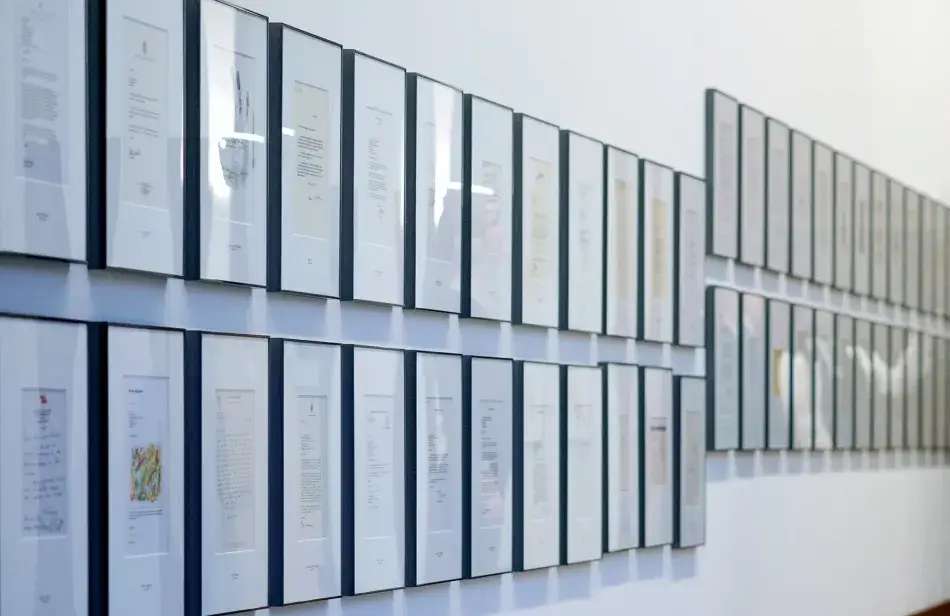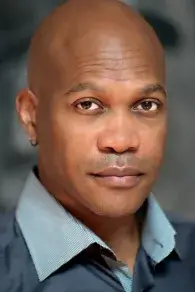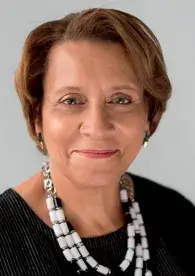
Since the Academy was established, newly elected members have written letters of acceptance, from George Washington in 1781 to the newest members elected in 2020.
A Letter Upon Election

E. Patrick Johnson, elected to the Academy in 2020, is a scholar and performer whose work incorporates race, class, gender, and sexuality. When he sent this letter, he was the Carlos Montezuma Professor of African American Studies and Performance Studies in the Weinberg College of Arts and Sciences and School of Communication at Northwestern University. On August 1, 2020, he became the Dean of the School of Communication at Northwestern and was named an Annenberg University Professor.
April 30, 2020
Dear Dr. Andrews and Dr. Oxtoby,
It is with the utmost joy and deep sense of humility that I accept membership into the American Academy of Arts and Sciences. Given the magnitude of this honor, words cannot express how moved I am to be asked to join such an esteemed group of scholars, artists, scientists, thought leaders, and policymakers.
I have dedicated my entire scholarly and artistic career to lifting up the voices of those who have not always had a platform from which to validate and affirm their lives. Prime among these marginalized voices are my maternal grandmother, Mary Lewis Adams, and my mother, Sarah M. Johnson, both of whom are now deceased, but whose stories live on through the words I’ve written about them and, hopefully, through the life I lead. While neither of these women completed high school they were indeed the smartest people I have ever known not only because they “made a way out of no way,” to help their families survive, but also because they were philosophers at heart, imparting knowledge that came from their life experiences. Because of their mother wit I have been afforded so many opportunities that they would never have imagined for themselves – except through their hopes and dreams for me.
Through my contributions to the American Academy of Arts and Sciences, I hope to live up to the standards set by these two brilliant women by always doing the work that transforms society for the greater good.
Sincerely,
E. Patrick Johnson
and Letters Upon Reflection
Given the Academy’s founding in 1780, it would be reasonable to assume that its Archives would offer insights into how members experienced the War of 1812, the Civil War, World War I, the 1918 Influenza, and other major events that shaped life and death in America. However, the Academy’s Archives offer few records of those defining moments and how they were lived and understood by Academy members at that time.
The year 2020 will be different.
In May, the Academy started asking members to share how they were experiencing the pandemic. It was an opportunity for individuals to pause and assess. For the Academy, it was an opportunity to provide the present and the future with some perspectives from all the different vantage points that members offer.
Early replies focused on the pandemic.
Robert Langer (Massachusetts Institute of Technology) wrote that he was working harder than ever. His COVID-related projects included designing face masks, assessing experimental vaccines, and developing a painless device to draw blood for antibody tests. He concluded his reflection with “I very much hope that things get better. And I feel Science, of course, is critical to making that happen.”
Sherry Lansing (Sherry Lansing Foundation) shared a quotation that resonated with her, which she hoped would be true of the aftermath of the coronavirus: “The comeback is always stronger than the setback.”
Cherry Murray (University of Arizona) sent a multi-limerick poem, “COVID-19 Spring and Summer,” that included the following stanza:
While leaders are boasting and rambling,
world scientists together are scrambling
to develop vaccines
or find treatments that ease
the suffering, so life is not gambling.
Pauline Yu (American Council of Learned Societies) wrote, “I grieve for my city of New York and the future of its beloved restaurants and cultural institutions. I weep at performances by quarantined musicians who, though isolated, play perfectly in concert because music means so much to them, and to us. I bemoan the longstanding divisions and inequities in this country that have inflicted disproportionate suffering on the disadvantaged and most vulnerable populations.”
Then came the murder of George Floyd, which galvanized protests for racial justice across the country. Subsequent reflections included thoughts about pervasive injustice and what it means to face and address racism in our country.
Christiane Amanpour (CNN) shared that out of the catastrophic coronavirus pandemic, she was “imagining and hoping for a total global reset. The deep losses of life and livelihoods will only be justified if we can emerge into a new era of civilization where we create justice, less inequality, care for our communities and our planet, a better, more human society. And from this twin pandemic of shocking, inhumane, institutional racism, I hope finally we can, in the words of the Atlanta Rapper and activist Killer Mike, ‘Plot, Plan, Strategize, Organize, Mobilize’ our way to fulfilling the Founding Fathers’ sacred belief that all are born equal.”
Paula Giddings (Smith College) conveyed personal experience, expertise, and uncertainty about what lies ahead. Her reflection is reprinted on the next pages.
Glenn Hutchins (North Island), reflecting on the inevitability of the protests, wrote: “Our lives will be forever marked – in ways both small and large, personal and social, familial and institutional – by what we did (and didn’t do) during this time.”
The suggestion of reflection itself gave pause to philosopher Susan Wolf (University of North Carolina at Chapel Hill), who began her letter with the following: “For better or for worse, I rarely ask myself how, or even what, I am feeling, and I am dispositionally uncomfortable about making general statements about the social or cultural significance of just about anything. But it seems to me a good thing for people to reflect, to notice, to attend to the way this (as we are constantly told) unprecedented situation is affecting us, both individually and communally, and so I welcome the assignment of a task that I would otherwise not have taken on.”
To document the present and to provide a resource for the future, the Academy invites and encourages all members to send their reflections, and any questions about this initiative, to Reflections@amacad.org. Emails, letters, drawings, and other forms of communication are welcome.
Reflections

Paula J. Giddings, a Fellow of the American Academy since 2017 and a member of the Academy’s Council, is Elizabeth A. Woodson 1922 Professor Emerita of Africana Studies at Smith College. She is the author of When and Where I Enter: The Impact of Black Women on Race and Sex in America; In Search of Sisterhood: Delta Sigma Theta and the Challenge of the Black Sorority Movement; and, most recently, the biography of anti-lynching activist Ida B. Wells, Ida: A Sword Among Lions, which won The Los Angeles Times Book Prize for Biography and was a finalist for the National Book Critics Circle award.
June 25, 2020
One of the scenes I have written about that left an indelible image in my mind was the April 19, 1892, Land Run to settle the Cheyenne and Arapaho lands. I pictured the thousands of homesteaders lining up in what would later become Oklahoma to wait for the huge bonfire that signaled the official opening of the land at 12 noon.
I remember thinking that if all had been equal – that is, if men and women of all races, ethnicities, economic standing, age, sexual orientation, and religion had had the same opportunity to lay claim to each parcel – the result would have been a settlement of tremendous diversity. A settlement, like they say, that looks like America. Problem solved. No handwringing. No moral guilt. No special favor. No unearned disadvantage. But, of course, this is not what happened in Oklahoma or anywhere else.
Then I thought not only about the lost opportunity and promises unfulfilled but the tremendous effort it took, in its inexorable way, to secure the final outcome: Native Americans set upon tearful trails; dark necks slipped through rough nooses; Jews, Catholics, new immigrants, women, and Queers disdained. You get my drift.
Lessons have been learned. Gated communities, comfortable suburbs, leafy villages, tony city blocks – all took a tremendous effort to create. The same is true for inner cities.
One of my best friends lives on the edges of one in a medium-sized city. We have three-, four-, sometimes five-hour conversations that are kept percolating by the alchemy of similarities and differences between us. We both attended Howard University in the sixties, are writers (who wrote ill-conceived poems in our Black nationalist phase), and are interested in just about everything.
However, in temperament, he is all doom and dystopia with a light peaking from underneath; I am the light that sees the swamp just below.
We have been talking of COVID, of course, and the shock of our becoming an unfamiliar category: elderly with an underlying condition. (When did that happen?) In a way, the realization has made us pay even more attention to what has been happening since the murder of George Floyd.
I say, yes, we have seen protests before, but look at the scale of this one!
I say, diversity is “in,” not one iota of resistance.
I say, there is finally a broad consensus about police violence.
I say, statues are coming down.
I say, low-wage workers, many of them women of color, have become visible.
I say, Trump is toast.
He says, but what will really change?
The question makes my mind leave my own leafy village and travel to where he lives.
And despite all of the brilliance in the air right now, all of the lofty language, all of the favorable polls, I see no sign that the inner city and/or outer Black suburbs will change.
These places were hard to make, took a lot of effort. Take a city like Ferguson, Missouri, just outside of St. Louis, where the police killing of Michael Brown, an unarmed teenager, became the inflection point for the Black Lives Matter movement. It may surprise many that Ferguson was 1 percent Black in 1970, 14 percent Black in 1980, 25 percent Black in 1990, and 67 percent Black in 2010. Between 2000 and 2010 – 2012, Ferguson’s poor population doubled: one in four lived below the federal poverty line. While Ferguson was becoming a Black enclave, St. Louis was becoming increasingly white: from 36 percent in 2000 to 44 percent in 2010.
According to Richard Rothstein, who writes so insightfully about this subject, the demographic changes in Ferguson cannot be adequately explained by the singular Black presence followed by falling property values and white flight. This would be crime and prejudice enough. But what Rothstein delineates is worse. It is a full-fledged federal, state, and city conspiracy:
. . . zoning rules that classify white neighborhoods as residential and black neighborhoods as commercial or industrial; segregated public housing projects that replaced integrated low-income areas; federal subsidies for suburban development that are conditioned on African American exclusion; federal and local requirements for, and enhancement of, property deeds and neighborhood agreements that prohibited resale of white-owned property . . . to African Americans; tax favoritism for private institutions that practiced segregation; municipal boundary lines designed to separate black neighborhoods from white ones and to deny necessary services to the former; real estate, insurance, and banking regulators who tolerated and sometimes required racial segregation and urban renewal plans whose purpose was to shift black populations from central cities like St. Louis to inner-ring suburbs like Ferguson.
The late historian Stephanie Camp posited that “at heart of the process of enslavement was a geographical impulse to locate bondspeople in a plantation space.” Camp goes on to quote historian Winthrop Jordan, who found that it was confinement more than any other single quality that differentiated slavery from servitude. “Slaveholders,” Camp continues, “strove to create controlling landscapes that would determine the uses to which people put their bodies.” As other historians have noted, the root of many modern-day police forces were slave patrols – created first to confine, and then to punish with public display.
Efforts to escape these landscapes, slave and free, were also perilous. As part of Ida B. Wells’s anti-lynching campaign, she suggested that Black Memphians leave a city that could not protect them. Twenty percent eventually left Memphis; many went to Oklahoma to await the bonfire that signaled the April 19 opening of the land. They were in search of a place without racism. The search was unsustainable.
These landscapes will change or we will all be sucked into their sinkholes again and again. They are the legacy of America’s original sin; the ultimate race relation. The next George Floyd, the next Breonna Taylor, is already in the site of some centuries’ old barrel. Despite the everyday resilience called up by the confined, the corruption, the violence, the hardness, the bad health, the no-opportunity, the bad education will continue to take its toll.
There will be some reform and reward in this moment: new laws, higher-paying jobs, more funds for organizations, corporate promotions, book advances, endowed chairs, and media projects – most of which will be given to deserving recipients. But without a fundamental reckoning for the inner cities, all of that merely becomes the measure of “progress” required to maintain the status quo.
Where my friend and I differ is that I believe since these landscapes are socially – and consciously – constructed, the strictures can be undone, even though the swamp, strewn with long-held and deep-pocketed interests, is a formidable one.
He thinks that the tentacles are too deep to dislodge, that we don’t have the will to be rattled to the core, that the moment to create a clean starting line has passed – though he hopes it hasn’t.
We’ll see.
– Paula J. Giddings
Bibliographical References
Stephanie Camp, “The Pleasures of Resistance: Enslaved Women and Body Politics in the Plantation South, 1830 – 1861,” The Journal of Southern History 68 (3) (August 2002).
Richard Rothstein, “The Making of Ferguson: Public Policies at the Root of the Troubles,” Report of the Economic Policy Institute, October 15, 2014.